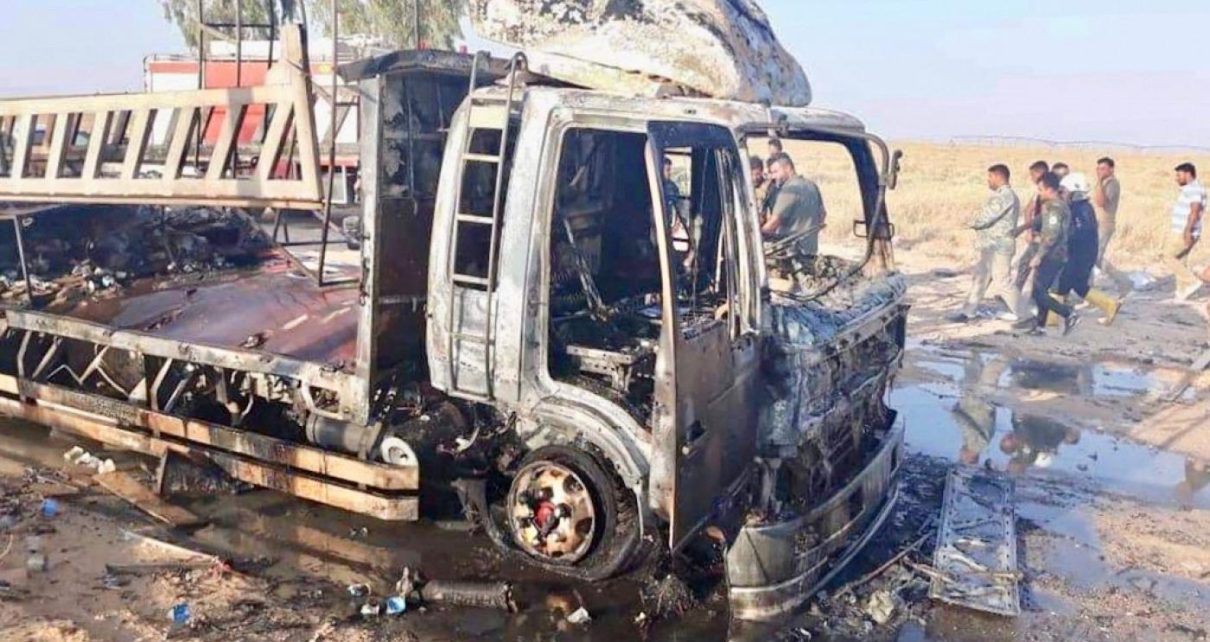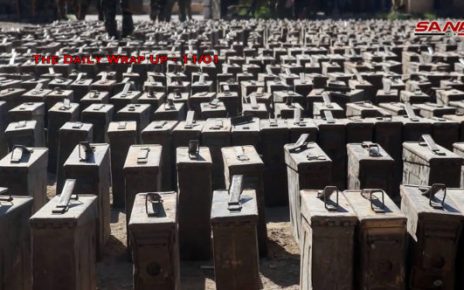Drone strikes were launched against a convoy of trucks, carrying fuel, along the Syria-Iraq border this Wednesday morning, reportedly causing up to 25 deaths. Despite the possible implications of the attack, it has gone largely underreported in Western media.
A fuel convoy, consisting of around 22 trucks, came under attack from Israeli drone strikes this Wednesday morning, in which 2 trucks exploded as a result. When initial news of the attack emerged, the usual conglomerate of anti-Syrian government media sites jumped on the story to claim that Iran-backed fighters had been killed. In addition to this, Iranian State-owned media outlets initially claimed that the US Government had launched the airstrikes, which added to confusion and has led to a situation where it is currently being stated that unidentified drones carried out the attack.
Reports have indicated that up to 25 people were killed in the attack, with around 10 injured. The reports on injuries do seem to appear the same throughout several accounts of the casualties, however, at this moment the precise number is difficult to tell with any level of certainty. There are many conflicting reports about the nature of the attack and depending upon which version is the correct one, the potential consequences drastically change.
What Really Happened?
Israeli and some Syrian opposition media outlets have attempted to frame the strikes as an attack on “Iran militias” and Iranian backed armed groups. These accounts of what happened are provably incorrect, as there were no military bases struck as has been claimed.
Syrian, Iranian, and Iraqi media have all said that a fuel convoy was struck, as the US Government denies and distances itself from the attack. According to Reuters, Iraqi officials have stated that not only were they aware of the fuel convoy, it had been officially approved by Baghdad to travel across the border.
According to the Syrian Observatory for Human Rights (SOHR), some of the trucks in the convoy that were hit were carrying weapons, however, the SOHR is known for routinely making things up out of thin air and is the only origin of this story about any alleged weapons transfers. In an Al-Jazeera English article, the SOHR is used as a source for claims that Iran was attempting to supply weapons to groups operating in Syria’s Deir Ezzor province.
On the other hand, the Lebanon-based media outlet Al-Mayadeen claimed before anyone that the airstrikes had been carried out by an Israeli drone. The Al-Mayadeen sources on the ground stated that a fuel convoy had been hit and did not speculate until later over casualty figures. An IRIB reporter in Iraq also claimed that the strikes were committed by Israel. The Washington Post is claiming that “paramilitary officers” in Iraq have stated that Iranians were killed in the strikes, a claim that could have massive implications.
Without going any further into the various reports on what occurred, here are the conclusions that can be drawn. All of the reporting indicates that drone strikes were carried out against a fuel convoy, it is also widely accepted at this point that the convoy was headed to Lebanon and that the fuel came from Iran. The Al-Qaim crossing area, close to where the attack took place is a frequent spot for the movement of Iranian-allied Iraqi militia forces and it is likely that these Iraqi forces were involved in some part of the safety of the transfer. There is no indication that the target was military in nature and the US is claiming that it had nothing to do with what just occurred.
The claim from the US could very well be true, in fact they have very little reason to lie about it at this point and there would be more suspicion if they would have just remained quiet. The US Biden administration has already launched a number of strikes against Iran-allied militia groups in Eastern Syria proudly. An argument that is being made, by the likes of The Times of Israel is that there could be some possible correlation between the drive-by shooting of a USAID worker on Tuesday and the Wednesday morning strikes. If the US believes that this was the doing of Iran, or its allies, it could have carried out a retaliatory strike, however, this is not exactly the most intelligent target, if so. Especially if Iranians have been killed, it could well cause an unwanted backlash, and from a strategic perspective, it makes more sense to just continue on with backing civil unrest in order to pressure Tehran.
Israel, on the other hand, did remain silent and after its routine attack on Syria, as it rarely admits that it conducts such strikes. Tel Aviv has struck Eastern Syria a number of times before and has a military base set up in North Eastern Syria, as well as possible launch sites for drones under its control in Northern Iraq too. Israel has also just admitted the extent to which its drones have been used throughout the Middle East, in a bragging manner. For Tel Aviv to strike a fuel convoy on its way to help supply Lebanon, it would make great sense from their perspective. Israel seeks any chance to score a victory over Hezbollah and making a trade route too dangerous for Iran to transport fuel to Lebanon, would achieve that goal.
In the past, fuel shipments through Syria have come with the threat from Hezbollah’s Secretary General, Seyyed Hassan Nasrallah, that if the fuel is touched then there will be an immediate retaliation. However, this time, no such threat was made and Israel may have seen this convoy as an easy target, given that there are no air defense systems in place in Eastern Syria. The Syrian Arab Army (SAA) never retaliates to Israeli airstrikes and the Iraqi PMU did not even retaliate to the US assassination of their top leader Abu Mahdi al-Muhandis, let alone Israeli drone attacks. The Israeli media reports, which attempt to falsely claim that the airstrikes targeted militant sites in Syria, may be seeking to moralize what has just occurred and fit it into a pattern of Israeli action against Iranian involvement in Syria. It is also important to note that if Iran, an ally of Syria, was in fact present in the country, this would not be a crime, let alone a legal justification for airstrikes, that often take place in civilian areas.
If Iranians were killed in the attack, however, this could possibly up the stakes, as Tehran has confronted foreign interference in their country’s internal affairs for the past 7 weeks. US intelligence reports indicate that Iran may be threatening strikes on US and Saudi targets in the Middle East, something that certainly seems on the table for Iran, if only for the purposes of psychological warfare. In the final analysis, there seems to be two possible options as to who could have been behind this attack on the fuel convoys, intended to help the people of Lebanon; the US or Israel. In my analysis, it seems much more likely that Tel Aviv was behind this unprovoked attack.





